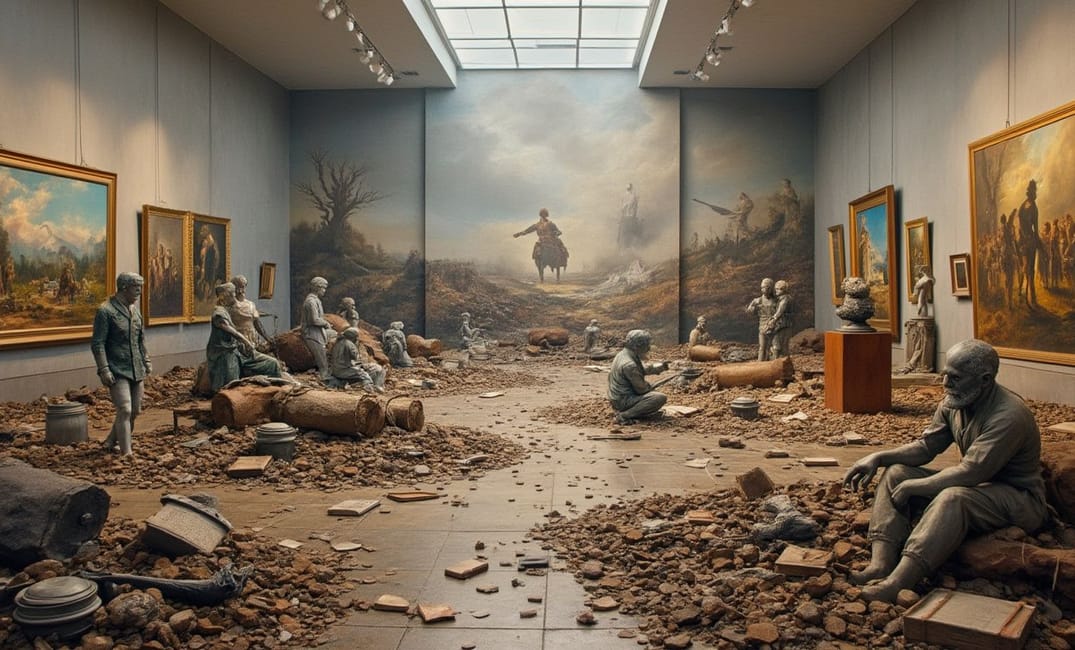The Dual Faces of Human Conflict
War and conflict have profoundly shaped human history, echoing across time with tales of heroism, destruction, and rebirth. While wars reflect humanity’s most primal instincts, they also serve as catalysts for transformation and introspection. Conflict arises from desire, misunderstanding, and divergence, yet it also summons creativity and tenacity. This entry examines human conflict's historical impact and its profound reflections in art, revealing how we understand, process, and transcend our shadowed past through creativity.
The Historical Canvas of Human Combat
The Roots of Conflict: From Survival to Territory
- Prehistoric Struggles: Early human conflicts centered around resources, territory, and survival. Tribes clashed over hunting grounds, demonstrating hierarchical social dynamics rooted in evolutionary necessity. Artifacts like weapons and bones reveal latent aggression intertwined with survival strategies.
- Empire-Building and Territorial Expansion: As civilizations matured, so did the scale of human conflict. From the conquests of ancient Sumer to the vast expansions of Rome, empires sought resources and dominance. Conflicts became tools for sovereign legitimacy and cultural unification, etching stories of victory and tragedy across landscapes.
Ideological Battlegrounds: Faith and Nation
- Religious Wars and Crusades: Driven by faith, religious wars, like the Crusades, transcended territorial disputes to embody spiritual pursuits. Inter-religious conflicts sparked as narratives of righteousness clashed, entwining theology with power struggles.
- Nationalism and World Wars: The emergence of nation-states bore witness to ideological warfare, epitomized by world wars. The stories from these global conflagrations reveal nationalism's fervor, leading to shared suffering and eventual unified stances toward international diplomacy.
Creativity Amidst Chaos: Art as Witness and Healer
Painting the Human Experience: Emotions on Canvas
- Renaissance War Art and Humanism: Renaissance artists like Leonardo da Vinci captured war’s dual nature—the valor and despair. Paintings juxtaposed human suffering with eternal beauty, reflecting on the Renaissance ideals of humanism even amidst conflict.
- Impressionism and the Human Psyche: Impressionist artists, reacting to industrial warfare, focused on emotion and fleeting impressions of chaos and tranquility. Art from this era, like Monet's landscapes, embodied the transient beauty and alienation resulting from conflict.
Sculpting Remembrance: War Memorials and Monuments
- Memorializing the Fallen: Sculptures and monuments serve as physical embodiments of remembrance. Memorials from the World Wars, such as the Vietnam Veterans Memorial, evoke contemplation, inviting humanity to confront both loss and resilience etched into stone.
- Abstract War Symbolism: Abstract monuments offer unconventional interpretations, transcending specific conflicts to represent universal human suffering. Memorials, like Maya Lin's envisioned spaces, challenge viewers to internalize, reflect, and transform past traumas.
Literature and War: Narratives of Chaos and Resiliency
Poetry from the Trenches: Voices Shaped by War
- Wilfred Owen and the Tragedy of Combat: Poets like Wilfred Owen, through expressive stanzas, articulated the horror and futility of war, imbuing literature with vivid depictions of trench life and soldierly hardships. Poetry provided catharsis, transforming grief into resilience.
- Hemingway and the Lost Generation: Authors such as Ernest Hemingway dissected the disillusionment following global war. His prose, with understated clarity, broadcast the pervasive cynicism and search for meaning felt by a generation scarred by conflict.
Fictional Battlefields: War’s Impact on Society
- Tolstoy and the Human Condition: In works like "War and Peace," Tolstoy examined the chaotic intermingling of personal and political spheres. Fiction presented war not merely as historical backdrop but as a profound influence on individual destinies and societal consciousness.
- Orwell and Dystopian Concerns: George Orwell’s dystopian novels, such as "1984," reflect on power's potential for corruption and control. Through allegory, literature scrutinizes societal structures and war-induced shifts in human values and freedoms.
War and Cinematic Expression: Visual Narratives of Conflict
Documentaries and Historical Truth
- War Documentaries: Documentaries offer insightful, unabridged glimpses into zones of conflict, bridging firsthand perspectives with factual narrative. Films like "Apocalypse Now" explore the visceral realities of war, challenging audiences to confront uncomfortable truths.
- Propaganda and Ideological Films: Cinemas have wielded influence in shaping public perception of conflict, often through state-sponsored narratives. The medium becomes a powerful tool, balancing information dissemination with ideological reinforcement.
Fictional Retellings: Entertaining yet Insightful
- War Blockbusters and Epic Battles: Films like "Saving Private Ryan" harness visual spectacle, recreating the chaos and heroism of battlefields. Such films entertain while evoking empathy, encouraging collective remembrance and dialogue around human conflict's impacts.
- Alternative War Genres: Experimental war films break traditional narrative boundaries, focusing on internal psychological struggles. Movies like "The Thin Red Line" explore existential questions, reducing war to a backdrop against intense introspection.
War and Music: Soundscapes of Conflict
Music as Revolution and Resistance
- Folk and Protest Songs: Across centuries, music has served as a subversive form of resistance. Songs of protest, like Bob Dylan's anthems, embolden listeners, giving voice to dissent and hope amidst turbulent times.
- Chants and Hymns in Wartime: Chants and hymns resonate rhythmic unity during periods of conflict, fostering morale and solidarity. These musical expressions distill collective experiences, witnessing the enduring human spirit.
War Symphony and Composition
- Symphonies Inspired by Conflict: Composers like Shostakovich created symphonies, such as the Leningrad Symphony, echoing wartime experiences. Music conveys visceral emotion through harmonious yet tumultuous contrast, capturing landscapes of cultural and emotional warfare.
- Operatic Narratives and Battle Epics: Operas meld myth, history, and folklore, expanding narratives of conflict beyond reality. Epic productions, like Wagner's operas, embody both human triumph and folly in the face of destiny and adversity.
Conclusion: Transforming Shadows into Hope
As humanity navigates a tumultuous history marked by conflict, art stands illuminated as our beacon—both reflective lens and transformative tool. Through diverse expressions, art crystallizes war's impact, offering avenues for reflecting on legacies and redefining futures.
Art heals by fostering dialogue, provoking introspection, and highlighting potential paths toward reconciliation. War, in its darkness, inspires creation—a resilient reminder of humanity's ability to find meaning, generate hope, and strive for peace.
"In the alchemy of conflict, art forges light from shadow—an enduring testament to the unfolding brilliance of human resilience, courage, and hope’s triumphant return against all odds."
HUMAN CONFLICT, HUMAN RESILIENCE, ART, WAR, CINEMA, HISTORY, CREATIVITY, MUSIC, LITERATURE

